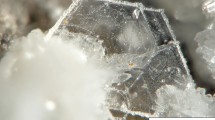Abstract
Lanmuchangite is a new thallium hydrous sulfate from the oxidation zone hosting rich thallium ore bodies in the Lanmuchang thallium (mercury) ore deposit, Xinren County, Guizhou Province, China. This new mineral is named after the locality where it was discovered. The mineral is associated with melanterite, pickeringite, potassium alum, jarosite, gypsum, arsenic blane, sulphur and some unknown minerals. The aggregates of lanmuchangite range from 2 to 10 mm in size. In general, the aggregates are compact and massive in form and are composed of anhedral granular crystals measuring in size from 40 to 90 μm, but the single crystal grains show distinct boundaries. Parallel columnar aggregates are occasionally seen, which are composed of subhedral to euhedral columnar crystals ranging in size from 15 to 65μm. White, light yellow to white in color, glassy in luster and transparent. Hvmesa = 94 - 124 kg/mm2,Hm =3.1 -3.4, density =2.22 g/cm3. Under the polarization microscope the mineral is colorless and homogeneous, with Nmeas = 1.495. It is easily water-soluble. The average chemical composition is; Tl2O = 33.25, A12O3 =8.07, SO3 =25.19, SiO2 =0.10, K2O=0.35, CaO=0.08, MgO=0.06, FeO=0.04 and H2O =33.46 [the crystal water (H2O) was measured by thermogravimetery (TG ) while the other composition were determined by electron microprobe ], totaling 100.60%. The empirical formula is (Tl1.00K0.03)1.05 (Al1.01 Si0.01Ca0.01 Mg0.01)1.04 [ SO4 ]2.01. 11.88 H2O and the simplified formula is TlAl[SO4]2. 12H2O. The compatibility of lanmuchangite is -0.03 and its value falls within the range of ± 0.020 — ±0.039, so the compatibility is excellent. Its TG curve demonstrated that the crystal water was lost (i. e., dewatering) in stages at 101, 130 and 230°C. At the temperature of 243°C the process of dewatering came to the end and the sum of lost crystal water reaches 33.30 wt%. IR spectroscopic analysis showed that the absorption bands 3374—3147 cm-1 and 1655—1648 cm-1 are due to tensile and bending vibration of crystal water molecules (H2O) whereas those at 1131 cm-1 and 605 cm-1 are attributed to tensile and bending vibration of group [ SO4 ]-2. Lanmuchangite is of the isometric system, with space group = Pa3,a = 12.212(5)Å, v = 1821(2)Å3, and Z=4. The strongest diffraction lines [d (I, hkl)] from the X-ray power diffraction data are 4.314(100, 220), 2.801(70, 331), 7.03(54, 111), 2.731(35, 420), 6.11(27, 200), 3.524(24, 222), 3.676(22, 311), 3.051(22, 400), 2.350(21, 511), 3.263(20, 321), 2.494(20,422), 1.932(19, 620).
Similar content being viewed by others
References
Chen Daiyan, 1989, The Discovery of thallium rich ore bodies in the thallium(mercury) ore deposit of China for the first time and preliminary study of its genesis [J]: Journal of Guizhou Institute of Technology, v. 17, n. 2, p. 1–20 (in Chinese with English abstract).
Chen Daiyan, 1989, The discovery of lorandite in China and its study [J]: Acta Mineralogica Sinica, v. 9, n. 2, p. 141–147 (in Chinese with English abstract).
Chen Daiyan and Zou Zhenxi, 2000, Situation about the Lanmuchang-type thallium (mercury) ore deposits in southwestern Guizhou [J]: Guizhou Geology, v. 17, n.41, p. 236–241 (in Chinese with English abstract).
Chen Guoxin and Chang Yueming, 1989, Manual of spectra of facies change of X-ray powder analysis and thermal analysis on minerals [M]: Chengdu, Science and Technology Press in Sichuan, 608p. (in Chinese)
Donald Bloss, F., Mickey Gunter, Su Shuchun, and H. E. Wolfe, 1983, Gladstone-dale constants; A new approach [J]: Canadian Mineralogist, v. 21, p. 93–99.
ICDD (International Contre for Diffraction Data), 1996, Powder diffraction file 6–10 sets; inorganic volume, published by the Joint Committee on Powder Diffraction Standards, 1845 Walmut Street, Philadelphia, Pennsylvania, 7–20, p. 164.
Mandarino, J. A., 1981, The Gladstone-Dale relationship; part IV. The compatibility concept and its application [J]; Canadian Mineralogist, v. 19, p. 441–450.
Peng Wenshi and Liu Gaokui, 1982, Manual of infrared spectra [M]: Beijing, Science Press, 508p. (in Chinese)
Wang Pu, Pan Zhaolu, and Wen Linbao, 1987, Systematic mineralogy [M]; Beijing, Geological Publishing House, v. 3, 734p. (in Chinese)
Author information
Authors and Affiliations
Additional information
This study was supported by the National Natural Science Foundation of China (Grant No. 49762008).
Rights and permissions
About this article
Cite this article
Daiyan, C., Guanxin, W., Zhenxi, Z. et al. Lanmuchangite, a new thallium (Hydrous) Sulphate from Lanmuchang, Guizhou Province, China. Chin. J. Geochem. 22, 185–192 (2003). https://doi.org/10.1007/BF02831529
Issue Date:
DOI: https://doi.org/10.1007/BF02831529



